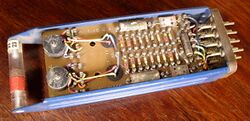Difference between revisions of "TX-2"
m (→External links: +A collection of images) |
(Its most important contributions were in software) |
||
| Line 1: | Line 1: | ||
[[Image:TX-2 module top.jpg|250px|thumb|right|TX-2 plug-in module]] | [[Image:TX-2 module top.jpg|250px|thumb|right|TX-2 plug-in module]] | ||
| − | The '''TX-2''' was an early [[transistor]] computer; it was a follow-on to the ground-breaking [[TX-0]] at the [[Massachusetts Institute of Technology|MIT]] [[Lincoln Laboratory]]. Innovations around [[interrupt]]s used on the TX-2 | + | The '''TX-2''' was an early [[transistor]] computer; it was a follow-on to the ground-breaking [[TX-0]] at the [[Massachusetts Institute of Technology|MIT]] [[Lincoln Laboratory]]. Innovations around [[interrupt]]s used on the TX-2 were an important predecessor to the [[PDP-1]]. Its most important contributions were in the [[software]] developed on it. |
| + | |||
| + | One important [[application]] developed on the TX-2 was the ground-breaking [[Sketchpad]]. Later on, an important [[data network]]ing demonstration that preceded the [[ARPANET]] used the TX-2. Beginning in 1964 a [[time-sharing]] system called [[APEX]] was put together on the TX-2, under the guidance of Larry Roberts, using a small number of consoles with [[graphics]] capability. | ||
The TX-2's [[magnetic tape]] [[mass storage]] system, created by Tom Stockebrand, used 1/2" tape, but was block addressable, unlike most magnetic tape systems, which could only write sequentially. He later moved to the [[LINC]] project, along with several other TX-2 alumni, where he helped create the descendant [[LINC tape]] system; he then moved to [[DEC]], where he helped create [[DECtape]], very similar to LINCtape. | The TX-2's [[magnetic tape]] [[mass storage]] system, created by Tom Stockebrand, used 1/2" tape, but was block addressable, unlike most magnetic tape systems, which could only write sequentially. He later moved to the [[LINC]] project, along with several other TX-2 alumni, where he helped create the descendant [[LINC tape]] system; he then moved to [[DEC]], where he helped create [[DECtape]], very similar to LINCtape. | ||
| − | |||
| − | |||
| − | |||
| − | |||
{{semi-stub}} | {{semi-stub}} | ||
| Line 24: | Line 22: | ||
* [https://web.stanford.edu/~learnest/nets/timesharing.htm Who invented Timesharing] | * [https://web.stanford.edu/~learnest/nets/timesharing.htm Who invented Timesharing] | ||
* [https://tx-2.github.io/ TX-2 simulation project] | * [https://tx-2.github.io/ TX-2 simulation project] | ||
| + | ** [https://tx-2.github.io/documentation/ TX-2 Documentation] | ||
[[Category: Mainframes]] | [[Category: Mainframes]] | ||
[[Category: 36-bit Computers]] | [[Category: 36-bit Computers]] | ||
[[Category: Unique Computers]] | [[Category: Unique Computers]] | ||
Revision as of 15:02, 25 October 2025
The TX-2 was an early transistor computer; it was a follow-on to the ground-breaking TX-0 at the MIT Lincoln Laboratory. Innovations around interrupts used on the TX-2 were an important predecessor to the PDP-1. Its most important contributions were in the software developed on it.
One important application developed on the TX-2 was the ground-breaking Sketchpad. Later on, an important data networking demonstration that preceded the ARPANET used the TX-2. Beginning in 1964 a time-sharing system called APEX was put together on the TX-2, under the guidance of Larry Roberts, using a small number of consoles with graphics capability.
The TX-2's magnetic tape mass storage system, created by Tom Stockebrand, used 1/2" tape, but was block addressable, unlike most magnetic tape systems, which could only write sequentially. He later moved to the LINC project, along with several other TX-2 alumni, where he helped create the descendant LINC tape system; he then moved to DEC, where he helped create DECtape, very similar to LINCtape.
Further reading
- C. Gordon Bell, Gerald Butler, Robert Gray, John E. Mcnamara, Donald Vonada, and Ronald Wilson, The PDP-1 and Other 18-Bit Computers, in C. Gordon Bell, J. Craig Mudge, John. E. McNamara, Computer Engineering: A DEC View of Hardware Systems Design, Digital Press, Bedford, 1978
- Severo M. Ornstein, Computing in the Middle Ages: A View From the Trenches 1955-1983 (AuthorHouse, 2002) - Some background about the end of the construction of the TX-2
External links
- Bitsavers TX-2 documents
- TX-2 Circuitry Handbook
- TX-2 Computer - a collection of images
- The LINC Was Early and Small - lengthy personal memoir by Wesley Clark; it also mentions the TX-2
- Who invented Timesharing
- TX-2 simulation project
